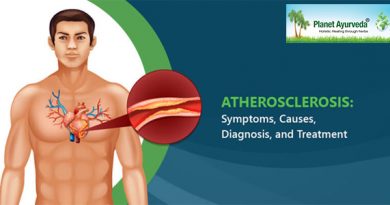How to Maintain Healthy Lifestyle with Ayurveda
Ayurveda is one of the main and ancient life sciences, for centuries on this planet. It’s not merely a medicinal science for treatment, but it’s much more than that. It’s a way of life. It teaches us how to live a life without any ailments with vigor and vitality, a life which is without any “Roga”( the body which is inflicted with the disease). The main aim of Ayurveda is to provide and maintain a good healthy body and preventing it from the diseases through a healthy lifestyle and a good diet. According to Ayurveda, life is the combination of mental, physical and spiritual factors. ”Satwa” mind, spirit” Atma” the main root of the body. The physical world and human body both have the combination of five fundamental entities “Akash, Vayu, Jal, Agni, Prithvi”, a combination of all these five It’s Its element is known as panchmahabhutas and the soul.
Vata dosha, Pitta dosha, and Kapha dosha, a combination of all these three makes “Tridosha”, “Dhatus” for tissues and “Malas” for excretory products. Our sedentary and faulty lifestyle and our diet do affect the “Tridosha”. Hence vitiated Tridosha is the reason that affects the dhatus and malas causing abnormality in them, which is the root cause of diseases in the body. Thus its necessary for our well being to have all these Tridoshas in a properly balanced manner.
What are These three (Tridosha)?
1. Vata
Vata energy is associated with people who are original thinkers, creative and are of artistic nature. Vata energy is linked with movements of the body including breathing and circulation of blood properly and is associated with space and air (vayu)., I If this energy is not in balanced form then it can produce bad results like anxiety, constipation, joint pain dryness in skin, etc.
2. Pitta
When Pitta energy gets imbalanced, a person suffering from this imbalanced Pitta may complain of heartburn, digestive problems, ulcers, inflammation, anger, and arthritis. Pitta energy is associated with fire (Agni), the nature of people with (Agni )pitta, is warm and their temperament is fiery.
3. Kapha
A person suffering from Kapha imbalance may suffer from sinus, obesity, gallbladder problems followed by diabetes. The part of the body linked with Kapha are chest, torso, and back and it is associated with water and earth, “Prithvi” and “Jall”. People of this nature are calm.

Reasons for Unbalanced “Doshas”
According to Ayurveda’s unhealthy diet, poor lifestyle, stress, emotional phase of life such as strained relations, weather conditions of a country in which a person lives, all these factors make a person`s getting prone to these “Doshas”. Instead, Ayurveda teaches us the ways on how to live a healthy life.
According to Ayurveda, it is very rare that a person is having only a single dosha (“PURE DOSHA”). Most people have dual dosha. Pure dosha body type is better than dual dosha but as pure dosha people are very rare to find, that’s why we found almost dual dosha body type. The people have all three doshas equally in their bodies, like Vata, Pitta, and Kapha. Kapha is considered to be the best of all three doshas, but this type of dosha is found very rarely.
Nothing to worry…With the help of Ayurveda you can balance your doshas as Ayurveda shows us the correct way on how to live a healthy lifestyle with our “Ahar” – diet and “Vihar” – the way of our lifestyle is, and with “Vichar” means how to think positive thinking with a calm and balanced mind.
Effects of Tastes (Rasas) on Doshas
Nature has provided us six kinds of tastes, and every taste or (Rasas) is a combination of its two predominant elements, for e.g. sweet taste, consists of earth and water element.
- Sweet: It increases Kapha and decreases Vata and Pitta.
- Bitter: It consists of air and space, increases Vata and decreases Pitta and Kapha.
- Sour: It consists of earth and fire, increases Pitta and Kapha decreases Vata.
- Pungent: It consists of fire and air, increases Vata and pitta decreases Kapha.
- Astringent: It consists of air and earth, increases Vata and decreases Kapha and pitta.
- Salty: It consists of water and fire, increases pitta and Kapha decreases Vata.
To maintain a perfect balance in our body, we have to eat food containing all “Rasas” or tastes, as each dosha consists of two elements out of 5 elements, as it lacks other three so to balance the other three elements, we need to consume food which contains remaining 3 elements. Suppose we eat food with air and space element (food tasting bitter, astringent and pungent), it makes and revokes your Vata dosha to balance this. To achieve it, we have to eat food which consists of the remaining 3 elements water, fire, and earth and the food which contains tastes (“Rasas”) of sweet, sour and salty.
To maintain our Prakriti, we need to eat food by understanding its effect on the particular dosha.
Remedies to Manage Doshas, Signs, and Symptoms of Their Vitiation
1. Vata Dosha
Signs & Symptoms
Constipation, viral infections frequently as compared to normal, dehydration, disturbed sleep, difficulty in tolerating loud noises and weight loss.
Causes
Major causes for Vata dosha are:
Irregularity comes in daily activities, like eating, sleeping and working.
Loneliness creeps in, worrying, fearing, excessive thinking on useless things.
Eating too rapidly, drinking too much alcohol, taking drinks containing caffeine or black tea, eating cold, old, dry, leftover food, preserved and old sweets. Eating in depression, eating Vata-aggravated food, suppression of bodily urges, such as sneezing, passing gas, frequent elimination of waste materials like stool and urine.
Home Remedies To balance Vata dosha
Eat ripened fruits, oils of almond, sesame and cow ghee are preferred in maintaining the balance of Vata dosha. Salt, clove, cinnamon, cardamom, ginger, cumin are the spices preferred for Vata dosha’s balance. Raw honey, jaggery, maple syrup can also be taken.
2. Pitta dosha
Signs and Symptoms
Diarrhea, feeling anger and frustration, irritability, acidity, gastric, peptic ulcers, heartburn, inflammation in body and joints, inflamed rashes and red-colored acne on the skin texture, feeling uncomfortable, heat and warmth sensation in the body are the symptoms of unbalancing the Vata dosha.
Causes of Pitta losing its Balance
Smoking, being over-aggressive and competitive, overworking, eating, pitta aggravated food, eating in anger.
Home remedies: To balance Pitta dosha:
Include astringent, bitter and sweet taste in your food, warm milk with a small amount of cardamom and ginger in it, makes it a sweet food, use mild and cooling spices like coriander, cardamom, curry leaves, turmeric, cumin in your diet. Add cow ghee and olive oil as cooking oil.
3. Kapha Dosha
Signs and Symptoms
Increased cholesterol and triglycerides level in the body, cough, congestion and cold, slow and sluggish digestion, obese body, water retention and body becoming lethargic.
Causes of Kapha
Having excessive sleep, eating heavy meals and eating without hunger, eating salty, oily or fatty food, and not doing any physical work or exercise.
Home Remedies To Balance Kapha Dosha
Include pungent bitter and astringent taste to your diet.
Eat raw and boiled vegetables, steamed vegetables are also a very nice way to get rid of maintaining a solid balance of Kapha dosha. Add spices like black pepper, clove, turmeric mustard, cumin ginger, cardamom, cinnamon, basil, garlic, coriander in your daily diet. Use of honey instead of white sugar is best & healthy for use. All these herbs are useful in helping Kapha dosha. Minimize the use of heavy foods like salt, chocolates and dairy products.





